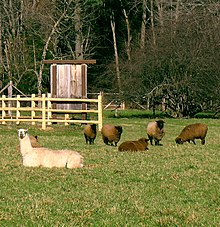
The coyote is a species of canine native to North America. It is smaller than its close relative, the wolf, and slightly smaller than the closely related eastern wolf and red wolf. It fills much of the same ecological niche as the golden jackal does in Eurasia. The coyote is larger and more predatory and was once referred to as the American jackal by a behavioral ecologist. Other historical names for the species include the prairie wolf and the brush wolf.

The Komondor, also known as the Hungarian sheepdog, is a large, white-coloured Hungarian breed of livestock guardian dog with a long, corded coat.

The llama is a domesticated South American camelid, widely used as a meat and pack animal by Andean cultures since the pre-Columbian era.
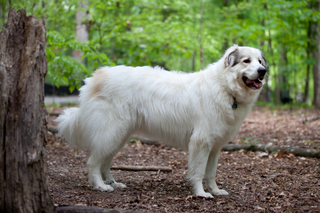
The Pyrenean Mountain Dog is a French breed of livestock guardian dog; in France it is commonly called the Patou. It originates from the eastern or French side of the Pyrenees Mountains that separate France and Spain. It is recognised as a separate breed from the Mastín del Pirineo or Pyrenean Mastiff from the Spanish side of the mountains, to which it is closely related.

The culpeo, also known as culpeo zorro, Andean zorro, Andean fox, Paramo wolf, Andean wolf, and colpeo fox, is a species of South American fox. Regardless of the name, it is not a true fox, but more closely related to wolves and jackals. Its appearance resembles that of foxes due to convergent evolution.

Herding is the act of bringing individual animals together into a group (herd), maintaining the group, and moving the group from place to place—or any combination of those. Herding can refer either to the process of animals forming herds in the wild, or to human intervention forming herds for some purpose. While the layperson uses the term "herding" to describe this human intervention, most individuals involved in the process term it mustering, "working stock", or droving.

A herding dog, also known as a stock dog, shepherd dog, sheep dog or working dog, is a type of dog that either has been trained in herding or belongs to breeds that are developed for herding.

A pack animal, also known as a sumpter animal or beast of burden, is an individual or type of working animal used by humans as means of transporting materials by attaching them so their weight bears on the animal's back, in contrast to draft animals which pull loads but do not carry them.

A guard dog or watchdog is a dog used to watch for and guard people or property against unwanted or unexpected human or animal intruders.

The Maremmano-Abruzzese Sheepdog, Italian: Cane da pastore Maremmano-Abruzzese, is an Italian breed of livestock guardian dog. It is indigenous to Central Italy, especially to the Maremma region of Tuscany and Lazio, and to northern areas of Southern Italy, particularly to Abruzzo. It has been used for centuries by Italian shepherds to guard sheep from wolves. The "Maremmano" name derives from that of the Maremma marshlands where, until recently, shepherds, dogs and hundreds of thousands of sheep over-wintered, and where the dogs are still abundant although sheep-farming has decreased substantially. However, the breed is still widely employed in and closely culturally associated with the nearby region of Abruzzo, where sheep herding remains vital to the rural economy and the wolf remains an active and protected predator. It may also be called Maremmano, Maremma Sheepdog or Abruzzese Sheepdog.

The Estrela Mountain Dog is a large breed of dog from the Estrela Mountains of Portugal bred to guard herds and homesteads. It is "one of the oldest breeds in the Iberian Peninsula."
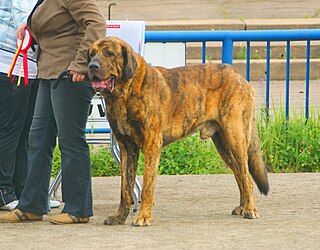
The Spanish Mastiff or Mastín Español is a breed of dog from Spain, originally bred to be a guard dog and whose specialized purpose is to be a livestock guardian dog protecting flocks and/or herds from wolves and other predators.
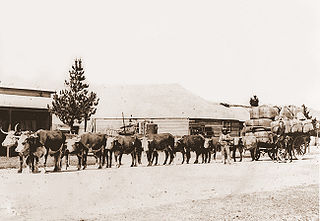
A working animal is an animal, usually domesticated, that is kept by humans and trained to perform tasks instead of being slaughtered to harvest animal products. Some are used for their physical strength or for transportation, while others are service animals trained to execute certain specialized tasks. They may also be used for milking or herding. Some, at the end of their working lives, may also be used for meat or leather.

The Central Asian Shepherd Dog, also known as the Alabay, Alabai and Turkmen Wolf-Hound, is a livestock guardian dog breed. Traditionally, the breed was used for guarding sheep and goat herds, as well as to protect and for guard duty. In 1990, the State Agroindustrial Committee of Turkmenistan approved the standard of the Turkmen Wolf-Hound dog breed.

The raising of domestic sheep has occurred in nearly every inhabited part of the globe, and the variations in cultures and languages which have kept sheep has produced a vast lexicon of unique terminology used to describe sheep husbandry.
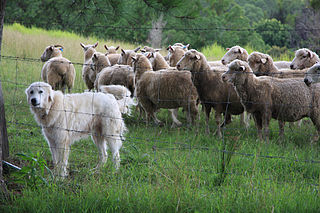
A livestock guardian dog (LGD) is a dog type bred for the purpose of protecting livestock from predators.

Along with parasites and disease, predation is a threat to sheep health and consequently to the profitability of sheep raising. Sheep have very little ability to defend themselves, even when compared with other prey species kept as livestock. Even if sheep are not directly bitten or survive an attack, they may die from panic or from injuries sustained.

Sheep or domestic sheep are a domesticated, ruminant mammal typically kept as livestock. Although the term sheep can apply to other species in the genus Ovis, in everyday usage it almost always refers to domesticated sheep. Like all ruminants, sheep are members of the order Artiodactyla, the even-toed ungulates. Numbering a little over one billion, domestic sheep are also the most numerous species of sheep. An adult female is referred to as a ewe, an intact male as a ram, occasionally a tup, a castrated male as a wether, and a young sheep as a lamb.

The Aksaray Malaklısı or Malaklı Karabaş is a breed of large livestock guardian dog, from the Aksaray Province in central Anatolia, part of Turkey. They are also known as the Turkish Mastiff or Anatolian Lion.

The Cão de Gado Transmontano or Transmontano Mastiff is a breed of livestock guardian dog from Portugal. It originates in the historical province of Trás-os-Montes e Alto Douro in north-eastern Portugal, and is a rare breed confined mostly to this area.
